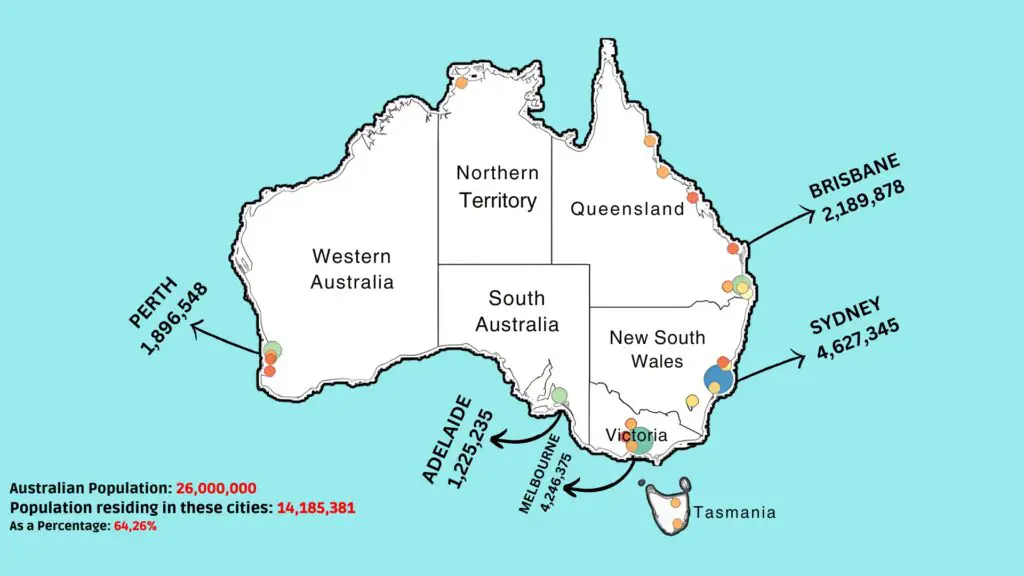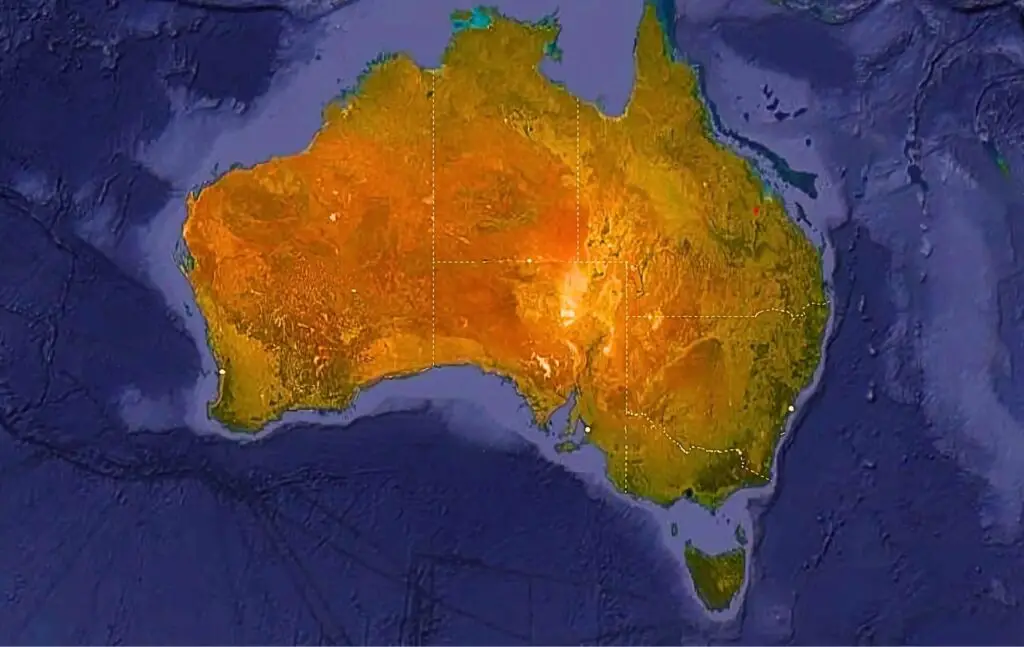Introduction
Why is Most of Australia Empty?: Australia has one of the lowest population densities in the world, with a land area of approximately 7.7 million square kilometers. This may come as a surprise given how frequently we hear about Australia on a global scale, yet the country’s landmass is only about 3% occupied.
Table of Contents
ToggleWith a population of slightly over 26 million, Australia is the sixth largest country in the world. This means that there are large areas of uninhabited land where you can travel for hours without seeing another person or even a town, but what are the real causes of this low population density and what does this mean for Australia’s future? In order to uncover the reason for less population, it is important we understand 3 important contexts that are:
- History
- Geography/Climate
- Population
History
Australia’s past is a hybrid of contemporary colonialism and prehistoric indigenous civilization. Before European settlers arrived, Indigenous Australians lived on the continent for more than 65,000 years. The intricate communities, customs, and strong relationships to the land that these Aboriginal and Torres Strait Islander peoples created helped to shape their way of life.
The British founded a penal colony at Botany Bay in 1788, and subsequently relocated it to Sydney, marking the start of European settlement. The foundation for colonization was established by Captain James Cook’s 1770 discovery of Australia. The British extended their rule over the area during the ensuing decades, which frequently resulted in violent conflicts with the Indigenous population, who were forced to flee their homes and face diseases introduced by the Europeans. A consolidation of Australia’s history is described below: –
|
Colonization and Indigenous Displacement |
|
The colonization of Australia drastically reduced the Indigenous population due to violence, diseases, and land dispossession. Before European settlement, the Indigenous population was estimated at around 750,000. Today, Indigenous Australians represent about 3.3% of the population, a testament to the lasting effects of colonial history. |
|
Immigration Waves |
|
The discovery of gold in the 1850s triggered waves of immigration from Europe, particularly from the UK, Ireland, and later Italy and Greece. These immigration waves significantly grew Australia’s population and shaped its multicultural identity. |
|
Immigration Policies |
|
After WWII, Australia encouraged European migration through the “populate or perish” policy to boost its population and labor force, fearing potential threats from nearby Asia. However, restrictive policies, such as the White Australia Policy (1901-1973), limited immigration primarily to Europeans, maintaining a largely homogeneous population until it was dismantled. |
|
Low Population Density |
|
Despite its large size, Australia’s population density is very low (around 26 million people over 7.6 million square kilometers). Much of the interior is uninhabitable desert or arid land, confining most of the population to coastal regions. This geographic factor has kept the population concentrated in cities like Sydney, Melbourne, and Brisbane. Australia’s harsh climate, particularly in its vast interior, combined with limited water resources and arable land, has restricted settlement in much of the country, contributing to the low population density. |
Population Outlook
In term of landmass Australia stretches nearly 4000 kilometers between its West and East points and 3860 kilometers between the North and South, if we draw a competitive analysis and put Australian map over Europe it is nearly 24 percent larger than Europe and if we talk about population of Australia, it is 26 million people which is actually less than many countries such as Germany, France, Italy, Spain, Ukraine and Poland. Comparative analysis of population of Australia is mentioned below: –
Country/City | Population | Landmass | Population Density per KM |
Australia | 26 million | 7688286 Km2 | 3 per Km2 |
UK | 69 million | 241931 Km2 | 286 per Km2 |
California | 38 million | 423960 Km2 | 97 per Km2 |
Samantra (Island) | 60 million | 473,481 km² | 125 per Km2 |
When compared to the UK, the population of UK is actually more than double. If we explore further this demographic difference is even more pronounced because some U.S. states have higher populations than Australia, including California. Additionally, because Australia is an island, it is interesting to note that much smaller islands have higher populations than Australia for example a small Indonesian island Sumatra is nearly 60 times smaller than Australia but population is nearly thrice.
Surprisingly Australia is highly urbanized country. Despite less population its cities are among the most heavily urbanized in the world with 90% of the population concentrated in relatively small urban areas in fact nearly 2 out of every three are Australians live in one of the five major cities being Sydney Melbourne Brisbane Perth and Adelaide (see table below for details) so that’s why we say that there are both geographical and historical reasons why Australia disproportionately populated country.
City | Population |
Melbourne | 4,246,375 |
Brisbane | 2,189,878 |
Perth | 1,896,548 |
Adelaide | 1,225,235 |
Sydney | 4,627,345 |
Australia’s Geographical outlook
Australia is the sixth-largest country in the world, covering approximately 7.7 million square kilometers. Despite its size, it has a relatively small population, concentrated mainly in urban coastal areas. Australia is located in the Southern Hemisphere, Australia’s geography is highly varied, with a mix of deserts, tropical rainforests, mountain ranges, and fertile coastal plains. Approximately 70% of the country is arid or semi-arid, dominated by vast desert areas.
The Outback, located in the interior, is a large, sparsely populated desert region. Major deserts include the Great Victoria Desert and the Simpson Desert. The Great Dividing Range runs along the eastern coast and is Australia’s most significant mountain range. It includes Mount Kosciuszko, the highest peak on the mainland at 2,228 meters. Australia’s eastern and southeastern coasts are more fertile and densely populated.
The Great Barrier Reef, the world’s largest coral reef system, is located off the northeast coast in the Coral Sea. In order to understand why Australian population Is less it is important to understand that what landmasses or waterbodies are surrounding Australia and how they affect the climate of Australia, table below elaborates the likely effects of surrounding areas.
|
Location |
Likely Effects |
|
Northern Australia
Malaysia, Singapore, and the Philippines. Arafura Sea and Timor Sea |
The proximity of the Arafura Sea helps maintain the tropical climate in northern Australia, particularly in regions like Queensland. During the wet season (November to April), moist air from the Arafura Sea is drawn inland by the Northwest Monsoon. This contributes to the heavy rains that characterize northern Australia’s wet season, which supports the lush vegetation and ecosystems in these areas. |
|
South of Australia Southern Ocean, Tasmania, Bass Strait, Antarctica |
Cold Fronts: Cold air masses originating from Antarctica regularly move northward and impact southern Australia, particularly during the winter. These fronts bring cooler temperatures, rainfall, and windy conditions, especially to cities like Melbourne, Adelaide, and Hobart. Southern Annular Mode (SAM): This is a climate driver that affects the storm track and wind patterns over the Southern Hemisphere. When SAM is in a positive phase, it tends to keep cold Antarctic winds further south, leading to drier conditions in southern Australia. In a negative phase, these winds shift north, resulting in cooler and wetter conditions for the southern regions. |
|
West Australia Indian Ocean, Africa |
Positive IOD: Warmer water near the coast of Africa and cooler water near Indonesia reduce the moisture available for monsoon rains in Australia Negative IOD: The opposite occurs, where warmer waters near Australia increase rainfall, particularly in northwestern Australia, and increase the likelihood of flooding |
|
East Australia Pacific Ocean, Coral Sea, New Zealand, Pacific Islands |
El Nino: During El Nino events, warmer water shifts toward the central and eastern Pacific, which leads to reduced rainfall, droughts, and higher temperatures in eastern and northern Australia. La Nina: In contrast, La Niña brings cooler sea surface temperatures to the Pacific near Australia, leading to increased rainfall, higher chances of flooding, and cooler temperatures, especially in northern and eastern Australia East Australian Current: This warm ocean current flows southward along the eastern coast, influencing the climate by increasing humidity and warmth in coastal areas, particularly in Queensland and New South Wales. |
|
Consolidation: Australia’s climate is shaped by a complex interaction of geographic and oceanic factors, including its proximity to the Antarctic, Pacific, and Indian Oceans, as well as smaller seas like the Arafura and Timor Seas. The country experiences extreme weather patterns due to its vast size and diverse landscapes. The cold fronts from Antarctica bring cooler temperatures and rainfall to the southern regions, while the Indian Ocean Dipole (IOD) and El Nino-Southern Oscillation (ENSO) phenomena heavily influence rainfall and drought patterns. Tropical cyclones, monsoons, and ocean currents, particularly from the Indian Ocean and Timor Sea, affect the northern and western coasts. These factors create a wide range of climatic zones, from the tropical north to the arid interior, highlighting Australia’s unique environmental challenges and resilience |
|
Analysis/Conclusion
One of the primary reasons for Australia’s low population density is its challenging environment. The arid and semi-arid interior, also known as the Outback, is largely uninhabitable due to scarce water resources and extreme temperatures. Australia faces water scarcity across much of the continent, exacerbated by the country’s highly variable rainfall.
Cities like Sydney, Melbourne, and Brisbane dominate the population landscape due to economic opportunities and access to better infrastructure. Meanwhile, the sparsely populated northern and interior regions remain largely untouched due to harsh climatic conditions and limited economic opportunities. Australia’s population paradox offers critical insights into how geography and climate shape human settlement patterns.
One lesson is that water availability is a crucial factor in determining where populations can thrive. In countries with vast uninhabited areas, like Australia, investment in water management infrastructure could make otherwise arid regions more livable. Additionally, Australia’s history demonstrates that immigration policies can have long-term demographic impacts, as restrictive measures can hinder population growth even when land is abundant.
Ultimately, Australia’s sparse population is a product of both natural and human forces. Its environmental challenges and colonial past have led to a population density much lower than that of countries with similar land sizes, reflecting the complex interplay between land, people, and resources.
Reference
Jupp, James. An immigrant nation seeks cohesion: Australia from 17a88. Anthem Press, 2018. Curnow, Ross, and Roger Wettenhall.
“Populate or Perish. Populate and Perish? Australian Immigration.” In National Approaches to the Administration of International Migration, pp. 11-31. IOS Press, 2010.
links:
http://www.bom.gov.au/
https://worldpopulationreview.com/




